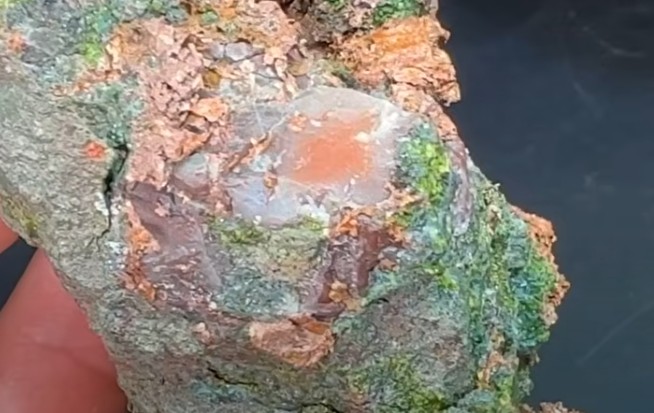DATOLITE
DATOLITE is named after a translation of a Greek word meaning “to divide,” after the granular structure of the minerals massive variety of formation and habit.
Datolite is a relatively uncommon mineral that occurs as a secondary mineral in mafic igneous rocks, geodes, tuffs, skarn in limestone, serpentinites, hornblende schist, and some ore veins.
OTHER NAMES:
Sugar stone – name sometimes applied to a pink datolite from the Keweenaw Peninsula of Michigan’s Upper Peninsula that has a slightly coarser “sugarlike” texture than that of the typical nodules.
It Fluoresces blue under SW UV
Botryolite is a botryoidal form of it.
USES
It can be used as a collector’s stone, an ornamental stone, and for creating jewelry.
Ornamental Stone: Datolite nodules, especially those from Michigan, are sliced and polished to reveal attractive color patterns, making them popular for ornamental displays.
Jewelry: The polished datolite nodules can be used to make unique jewelry pieces.
Collector’s Mineral: Datolite, particularly the large, well-formed crystals from Russia and the colored nodules from Michigan, are highly sought after by mineral collectors.
Industrial Use
- Boron Source: Datolite is an important source of boron, a key element in various industrial applications.
Product Manufacturing: The boron derived from datolite is used to produce items such as:
- Fiberglass
- Insulation
- Flares
- Rocket fuel igniters
MOHS HARDNESS
5 to 5.5. This hardness is consistent across its various forms, from its prismatic crystals to its massive and nodular varieties, though some sources specify 5.5 as a more precise value.
LUSTER
Vitreous to sub-resinous luster and is often found in association with zeolites and calcite in basalt cavities.
It may be brown, yellow, light green or colorless
CHEMICAL COMPOUND
CaBSiO₄(OH), making it a hydrous calcium boron silicate mineral. This mineral is composed of calcium (Ca), boron (B), silicon (Si), and oxygen (O) and also contains a hydroxyl (OH) group, which is what makes it a hydrous silicate.
WHERE TO FIND
Localities for fine specimens of Datolite include Norway, Germany, Italy, Austria, Japan, Russia, the USA, and Mexico, among many others.
In Michigan, it occurs only in the native copper deposits and their host rocks in the Northern Peninsula. It is present in most of the amygdaloids, especially in brecciated amygdaloidal lodes, including those found in the Pewabic, Osceola, Isle Royale, and Evergreen mines.
Unlike most localities throughout the world, the occurrence of Datolite in the Lake Superior region is usually fine grained in texture and possesses colored banding. Much of the coloration is due to the inclusion of copper or associated minerals in progressive stages of hydrothermal precipitation.
DIAGNOSTIC PROPERTIES
Its crystal structure can exhibit doubling in faceted gems due to high birefringence.
The datolite is found as nodules of massive, finely crystalline, material. The nodules usually do not show any datolite on the surface and are recognizable primarily due to the surface texture of the nodules (they look like the surface of cauliflower).
Crystals are typically colorless, white, or pale green to greenish yellow. Massive forms can be gray, pink, red, brown, or yellow.
